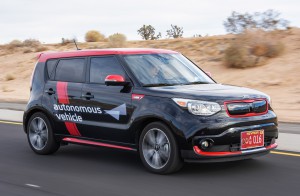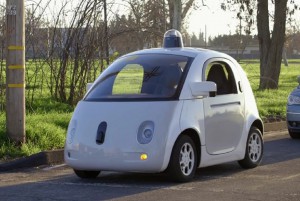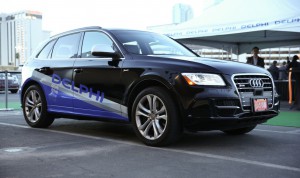
More and more makers, like Kia, are looking to grow the autonomous vehicle market, which is expected to hit 21 million vehicles by 2035.
Despite the results of survey after survey showing that motorists are overwhelmingly uncomfortable the idea of autonomous vehicles, sales of the self-drivers are expected to hit nearly 21 million by 2035: a jump over previous estimates.
“Global sales of autonomous vehicles will reach nearly 600,000 units in 2025,” said Egil Juliussen, Ph.D. and director of research at IHS Automotive.
“Our new forecast reflects a 43% compound annual growth rate between 2025 and 2035 – a decade of substantial growth, as driverless and self-driving cars alike are more widely adopted in all key global automotive markets.”
The news comes on the heels to two separate surveys in two countries saying that buyers aren’t really interested. According to a study by the University of Michigan Transportation Research Institute, or UMTRI. And more than a third said they would be “very concerned about riding in a completely self-driving vehicle.”
Asked what level of automation they would want in their vehicles, just 15.5% of the 618 respondents said they want something capable of complete self-driving. The figure rose to 38.7% for partially self-driving vehicles. But 45.8% said they want no autonomous capabilities at all.
One could argue that attitude is limited to the U.S., but American’s are apparently not alone in their feelings about self-drivers. According to a survey carried out by ICM Unlimited, 55% of the 2002 people surveyed in the United Kingdom said they were unlikely to want to be a passenger of a driverless car, with 40% saying they were very unlikely to want to be a passenger. Just 21% said they would be happy to ride in a driverless vehicle.

Despite a large number of motorists expressing distrust over self-driving vehicles, like Google's car, IHS revised its forecast for the vehicles upward.
(Most American motorists wary of self-driving cars. For more, Click Here.)
Despite a seemingly overwhelming level of discomfort with the idea of turning over control to a group of sensors and processors, there are other factors that appear to be pushing the autonomous vehicle forward in spite of these results.
New mobility solutions such as ride sharing and car sharing programs, increasing investment in autonomy by OEMs, suppliers and technology companies alike, research and development centers underway and improved efficiencies are expected to impact the further proliferation of automotive technologies.
However, perhaps the biggest factor is something simpler: inertia. Automakers, technology companies and suppliers are already working to perfect the technology. Much of it is already in use in bits and pieces on some vehicles. In short, the autonomous train has already left the station.
“Future mobility will connect and combine many different modes and technologies, and autonomous vehicles will play a central role,” said Jeremy Carlson, principal analyst at IHS Automotive.
(Click Here for details about GM’s plans for autonomous vehicles.)
“IHS expects entirely new vehicle segments to be created, in addition to traditional vehicles adding autonomous capabilities. Consumers gain new choices in personal mobility to complement mass transit, and these new choices will increasingly use battery electric and other efficient means of propulsion.”

Delphi is demonstrated the capability of its automated driving system by driving an Audi Q5 from San Francisco to New York City.
The first stop for the autonomous train will be the U.S., according to IHS, with several thousand autonomous vehicles in 2020, which will grow to nearly 4.5 million vehicles by 2035, according to IHS Automotive forecasts. As in many other markets, a variety of use cases and business models are expected to develop around consumer demand for personal mobility.
Chinese buyers and their love of technology and high-priced vehicles will – as it is for all vehicles – the biggest market for autonomous vehicles with 5.7 million units by 2035. Western Europe will fall in at 1.2 million, matched by Japan and South Korea collectively, and the Middle East and Africa will boast 1 million units by 2035.
The question now is: What kind of driverless vehicle will these buyers get. If it’s a General Motors product, it’ll have a steering wheel, brakes and a gas pedal to allow drivers to assume control in an emergency. Mary Barra told the media today prior to GM’s shareholder meeting that its autonomous vehicles in the future will come equipped with all of the conventional driver controls.
(GM and Lyft to begin testing autonomous vehicles. Click Here for more.)
Google, the tech behemoth that may be farthest along in the development of a viable self-driving vehicle, plans to equip its autonomous vehicles with nothing more than a bright red button that passengers can press in the event of an emergency.
